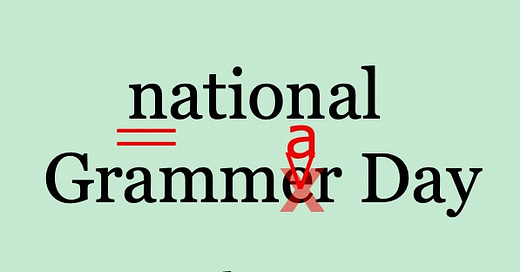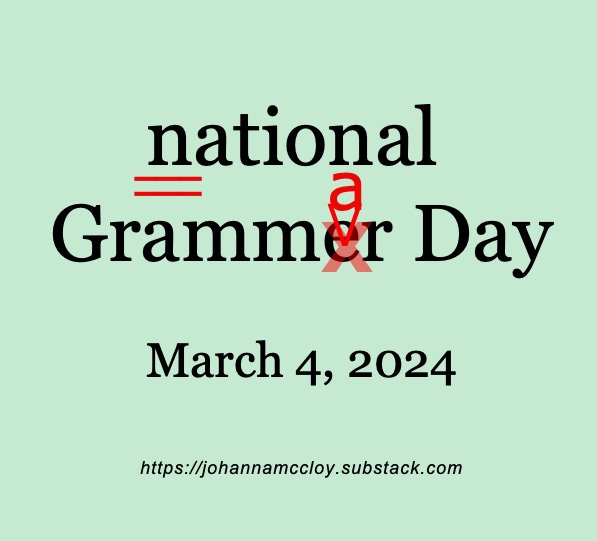“March forth on March 4 to speak well, write well, and help others do the same!"
~ Martha Brockenbrough, founder of National Grammar Day
I love her enthusiasm and cannot resist it. I shall march forth!
I’m a freelance editor, so I happen to love this stuff. I actually peruse the Chicago Manual of Style for fun.
It’s good timing too, considering the recent brouhaha over Merriam-Webster’s revised rule that sentences can indeed end with a preposition. (For more on that, here’s a brief piece from NPR’s Ari Shapiro.)
I featured a list of ten common grammar mistakes for Grammar Day last year, which generated a lot of replies. It was on the Dare to be Fabulous blog, before I began writing on Substack, so it is now reposted on In This Life for easy reference.
“Speak well, write well, and help others do the same!” That’s the idea with my list this year.
Here we go:
1. Space allotment after a period
I think most people are probably aware of this modified rule, but I’ve encountered some who are not, so I share this in case you are one of them.
It used to be standard to add two spaces after a period. This was because of typewriters. The ink of a typed period didn’t provide enough visual space to clearly denote the beginning of a new sentence, so adding a second space offered that visual clarity. As computer keyboards overtook typewriters and printer quality improved, that issue became irrelevant and the rule was revised. You only need to add one space after a period. In fact, Microsoft Word started highlighting two spaces after a period as an error in its 2020 update.
Two spaces after a period looks like a gaping hole now. My husband jokes that “you can drive a truck through it.”
2. The ellipsis
An ellipsis is that set of three periods or dots, like this . . .
The ellipsis is used to signify a pause, a trailing off of thought, a missing word, or hesitation. You may not use ellipsis much in your own writing, but if you do, here’s the simple rule for how to type it: each period should have a space on either side. It’s another visual cue: three periods in a row looks too bunched up.
3. Two periods in a row?
If the end of your sentence ends with an abbreviation like U.S., or Inc., do you add another period after that last period? No. You do not. Just keep the one period. 😊 Example: “I work at McCloy Enterprises, Inc. Where do you work?”
4. The period with the quotation mark
Question: Does the period go a) inside the quotation mark, or b) outside the quotation mark? The answer is a) inside the quotation mark. Example: “Let’s go to that vegan Chinese place for dinner.”
5. Punctuation with parentheses
Even as an editor, remembering the rules of certain punctuation marks with parentheses can be tricky. I figure if that’s the case for me, it must also befuddle others. I’ll paste this online explanation from the Chicago Manual of Style for the general rules:
A sentence that stands alone within parentheses needs a period inside the parentheses to end it. (Here’s an example.) A sentence in parentheses within another sentence does not take a period, because the period is reserved for the main sentence (questions and exclamations, however, must have their respective marks!). An abbreviation that ends with a period must not be left hanging without it (in parentheses, e.g.), and a sentence containing a parenthesis must itself have terminal punctuation (are we almost done?). Finally, an abbreviation ending with a period that is immediately followed by a question mark or exclamation point requires both marks (Q.E.D.!).
That last example might look odd with all that punctuation, but there you have it.
6. The hyphen (or dash), the en-dash, and the em-dash
Do you know the difference? The difference is the length, with the hyphen being the shortest and the em-dash the longest. (As the name connotes, the em-dash takes up the same space, in width, as the letter “M.”) The dash is on your keyboard. Computers and apps offer different ways to type out the latter two, so do a quick search for yours.
When do you use each one?
The hyphen (or dash) is used either as a “minus” indicator, like “10-5=5;” between words, like “far-fetched;” to spell out a word, like “a-p-p-l-e;” or to indicate stuttering, like “w-w-what?”
The en-dash is used to indicate time ranges like “1950 – 1960” or linkages like “the San Francisco – Oakland Ferry.”
The em-dash marks a break or interruption in a sentence, and is often used in place of a comma, colon, or semicolon. It usually does not have a space on either side. Example: “The em-dash—named for its width—is the same approximate width as the letter ‘M.’”
Incorrect phrases in the common vernacular
The incorrect use of certain words or grammatical phrases, when repeated and heard enough times, can become colloquialisms, fully accepted in casual conversation. The next three items fall into that category. I highlight these errors, because incorrect phrasing can begin to sound correct with enough repetition. This can lead to making associated errors with other phrases, which only come off as the errors they are.
7. “Drive safe”
This common send-off when someone heads to their car doesn’t make sense grammatically. You need an adverb after that verb. The correct phrase is “drive safely.”
The incorrect verb+adjective combination has become common in advertising slogans, which is unfortunate. Some examples include “think smart,” “buy local,” or “eat fresh.” Advertising plays with wording all the time and doesn’t need to adhere to grammatical rules.
8. “Graduated high school”
The verb “graduate” has several meanings. This one is defined, “successfully complete an academic degree, course of training, or high school” in the Oxford Dictionary. What’s wrong with the phrase above? You need “from.” When you graduate, you graduate from the school you attended. Example: “I graduated from Duke University.”
This phrase makes no sense without “from.” Think of it another way: if someone graduated early, would you say, “He graduated early high school?” No. You’d say, “He graduated early from high school.”
9. Filler phrases and answering a question with ”I mean . . . “
“I mean” has become one of those meaningless filler phrases like ‘um,” or “like,” or “you know.” Filler phrases don’t tend to make literal sense, but “I mean” is a relatively new one, which is why I bring it up. You’ll notice that more people now start to answer a question (any question), with “I mean,” which is redundant. But then, I suppose that’s not unlike starting with “honestly.” (Unless you’re usually dishonest?)
An interesting exercise is to monitor your own filler phrases. We say them pretty unconsciously, so you might be surprised by how often you use them, and even more surprised to discover which ones you use most.
10. Typical paragraph formatting for fiction vs. non-fiction
This last item is more of a “did you know that?” It likely won’t apply to you, unless you’re formatting a manuscript, in which case, good for you!
For fiction, new chapters or sections start with the first paragraph fully justified on both sides (a block paragraph). In subsequent paragraphs, the first sentence of each paragraph is indented.
For non-fiction (and some narrative non-fiction,) it’s the opposite: the first paragraph of a section or chapter is indented and subsequent paragraphs are block paragraphs, fully justified on both sides.
Interesting right? I don’t know why this is. Maybe it’s just a way to differentiate the genres, though I never noticed this until I formatted my own manuscripts.
Was anything on this list new or surprising to you?
Don’t forget to check out last year’s post listing ten common grammar mistakes.
Note: I provide writing and editing consultation and have helped clients with a variety of projects, including manuscripts, website content, and creative productions. 📖🖊️ 📺 🤩 If you’re on LinkedIn, you can find my profile there.
✳️ Thoughts? Like? I welcome your feedback. Please scroll down to like or comment.





I do love an ellipsis, and always thought it looked better with some space, but had no idea there was an official allocation of space . . . very cool. Fun piece, Johanna :)
Dang! I love the interest in this, as a writer/former English major/word prig, & appreciate the chance to learn more aspects of grammar. I knew nothing about the em- & en- dash, nor was I aware of the paragraph indent. Time to step it up. Many thanks for a great informative piece!